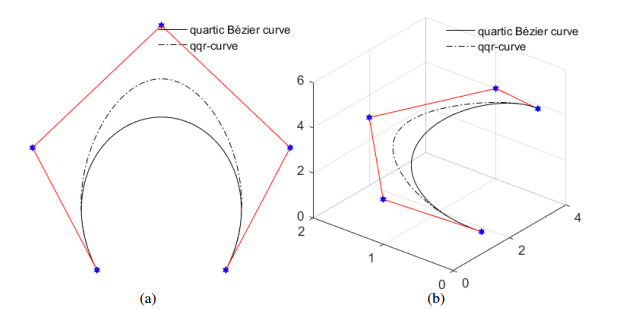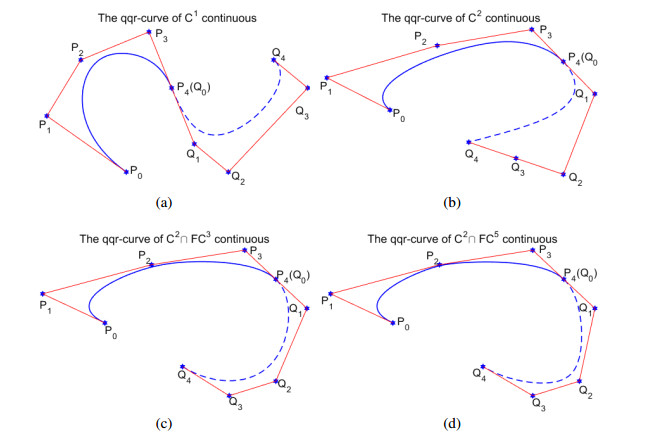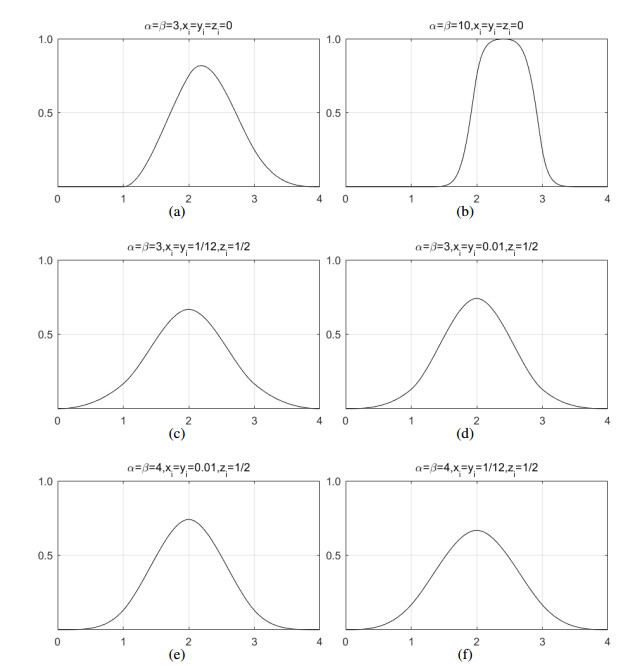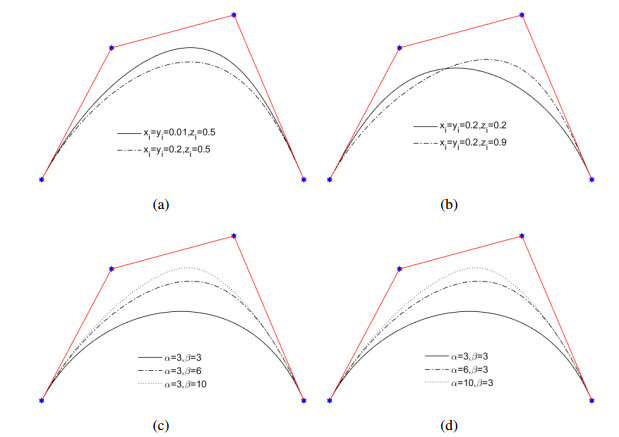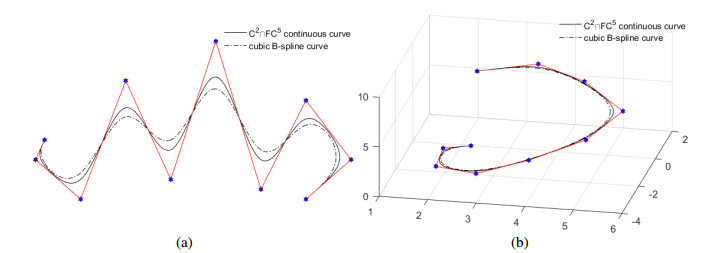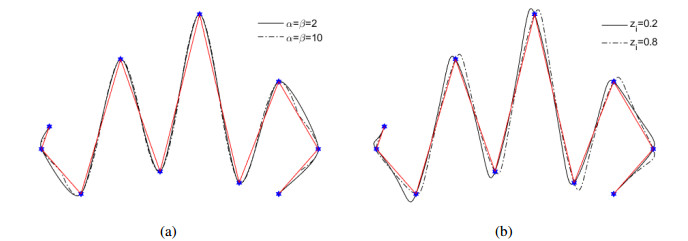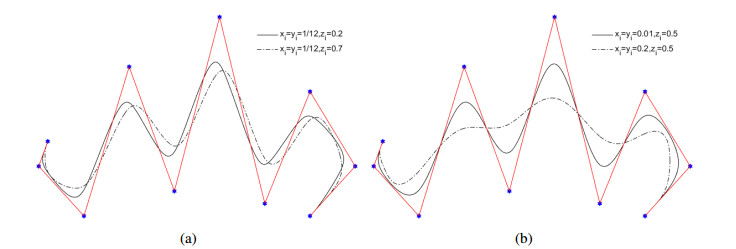A new quartic Bernstein-like basis possessing two exponential shape parameters is developed and the condition of C2 ∩ FC2l+3 continuity and the definition of such continuity-related curves are discussed. Based on this new basis, a new cubic B-spline-like basis possessing two global and three local shape parameters is presented and the related cubic B-spline-like curves have C2 ∩ FC2l+3 continuity at each point and include the classical cubic uniform curves as a special case. Representative properties regarding connecting, interpolation and local adjustment of the cubic Bspline-like curves are also discussed.
1.
Introduction
The construction of basis functions has always been an important topic in CAGD, especially the quadratic and cubic basis functions have a wide range of applications. In [1], Farin gives a kind of piecewise cubic B-spline curves, which are flexible and used conveniently. However, the shape of given curves are fixed to the related control points. For cubic rational B-spline curves, which possess a weight factor can be used to adjust shape of curves, however, improper use of weighting factors can lead to serious parameterization and even destroy the subsequent curve structure[2].
In order to improve the shape and the extent of adjustment of the curve, plenty of methods are generated. Where the most easily method is to add shape parameters to classical cubic Bézier and B-spline curves, the partly can be seen [3,4]. In recent years, researchers proposed some Bernstein basis possessing tension parameters. Hu et al. [5] constructed the developable Bézier-like surfaces using a new kind of cubic Bernstein-like basis with three local shape parameters. In [6], Cravero presented a C3 interpolation function, the shape of the related curves can be adjusted by tension parameters. In [14], Pelosi et al. proposed the quaternion representation for spatial PH cubics and gave results concerning existence of spatial PH cubic interpolants to given G1 Hermite data. In [17], Ait-Haddou et al. proved that the best constrained degree-reduced approximation is qual to the weighted least squares fit of the Bezier coefficients with factored Hahn weights and introduced parameters coming from the Jacobi norm. In [7], Wang constructed a new basis possessing denominator shape parameters, which is extended to B-spline curve and triangular domain. In [15], González constructed C2 algebraic-trigonometric pythagorean splines with different shape parameters. In order not to increase the computational complexity, some scholars have been studying the method of incorporating shape parameters without increasing the orders in n-order Bernstein basis. In [8], Liu gave a set of n-order Bernstein basis with multiple shape parameters in four cases. They have the same order as n-order Bernstein basis. In [9], Xiang improved this result. In the case of odd and even, respectively, a homogenous expansion polynomial with multiple shape parameters of n-order Bernstein basis is given. In [3], Qin et al. also gave the same expansion scheme of n-order Bernstein basis with multiple parameters. In [12], Hu et al. presented a novel shape-adjustable generalized Bézier curve with multiple shape parameters. And then, they extended the basis to rectangular domain[13]. Generally speaking, the extension method which does not increase degree to introduce parameters in Bernstein basis of degree n has faster calculation efficiency, while the extension method which introduces shape parameters by increasing degree of Bernstein basis has stronger ability of adjusting curve. Both of these methods have advantages, so the variable orders as shape parameters is a good choice. In [10], Costantini constructed a set of variable order basis functions in space {1,t,(1−t)m,tn}, and he studied its B-spline form. Subsequently, Costantini [11] extended this space to the space {1,t,t2,⋯,tn−2,(1−t)p,tq}. In[16], Zhu et al. constructed a quasi Bernstein basis with two shape parameters in space {1,3t2−2t3,(1−t)α,tβ}.
The purpose of this paper is to propose a new quartic Bernstein-like basis possessing two exponential shape parameters which serve as a tension parameters. Based on the new basis, a new cubic B-spline-like basis possessing two global and three local shape parameters is presented. And the related cubic B-spline-like curves have C2∩FC2l+3 continuity at each points and include the classical cubic uniform curves as a special case. The rest of this paper are organized as follows: Section 2 gives the definition and properties of the new quartic Bernstein-like basis possessing two exponential shape parameters. And the definition and the connecting conditions of the related curve are shown. Section 3 proposes the cubic B-spline-like basis. And the related properties of connecting, interpolation and locally adjustment of the cubic B-spline-like curves are discussed. The conclusion can be seen in Section 4.
2.
Construction of quartic Bézier-like curves
2.1. Quartic Bernstein-like basis functions
First, we give the definition of quartic Bernstein-like basis.
Definition 1. For any t∈[0,1], let α,β∈[2,+∞), we call the following five functions
as quartic Bernstein-like basis with two exponential shape parameters α and β.
Remark 1. When α=β=4, the qqr-basis will degenerate to the classical quartic Bernstein basis.
For the convenience of discussion, we will call the quartic Bernstein-like basis as qqr-basis. Also, we denote the qqr-basis functions as Ai(t;α,β)(i=0,1,⋯,4) or Ai(t;α)(i=0,1) and Ai(t;β)(i=3,4). Next, we will give the following lemma, which is used for the analysis of properties of the basis.
Lemma 1. For any t∈[0,1],λ∈[2,+∞), the expression F(t;λ)=1−3t2+2t3−λt(1−t)λ−1−(1−t)λ has a globally minimum value of 0.
Proof. We can easily verify that F(0,λ)=0,F(1,λ)=0,F(t,2), where t∈[0,1],λ∈[2,+∞). For any fixed t∈(0,1), we have
Actually, f′(t)=−t+2ln(1−t)(1−t)2<0 and g(0)=0. Thus, for t∈(0,1),t∈[2,+∞), we have
Therefore, for any fixed t∈(0,1), F(t,λ) increases with the increases of λ. From this, for arbitrary fixed t∈(0,1), F(t,λ) has a minimum value of F(t,2). Therefore, this lemma holds.
From the above definition of qqr-basis given in (2.1), we have some important properties as follows.
Theorem 1. The qqr-basis given in (2.1) possesses the following properties:
(1) Non-negativity: Ai(t;α,β)(i=0,1,⋯,4)≥0.
(2) Partition of unity: 4∑i=0Ai(t;α,β)=1.
(3) Symmetry: Ai(t;α,β)=A4−i(t;β,α)(i=0,1).
(4) Linear independence: For any (α,β)∈[2,+∞) and t∈[0,1], the qqr-basis Ai(t;α,β)(i=0,1,⋯,4) are linear independent.
(5) Endpoint properties: For any (α,β)∈[2,+∞), we have the following endpoint properties:
Also, for any (α,β)∈(2,+∞), we have
Proof. We will proof (1) and (4). The other cases can be easily verified.
(1) We can easily proof that Ai(t;α,β)≥0,i=0,1,3,4. Then, we only consider the basis A2(t;α,β). For α,β∈[2,+∞) and t∈[0,1], from the lemma 1, we have
(4) For α,β∈[2,+∞),λi∈R(i=0,1,2,3,4), we have the following linearly combination
Next, we will differentiate on the above linear combination, we can obtain
For t=0, the following linear equations can be obtained from (2.2), (2.3) and (2.4):
Therefore, it can conclude λ0=λ1=λ2=0. For t=1, from (2.2) and (2.3), we can get λ3=λ4=0, these imply the theorem.
Figure 1 shows the qqr-basis with different shape parameters.
2.2. Quartic Bézier-like curves
Definition 2. Given control points Pi(i=0,1,⋯,4) in R2 or R3, for any t∈[0,1],α,β∈[2,+∞), we call the expresiion
as the quartic Bézier-like curves with two exponential shape parameters α and β, where Ai(t;α,β) are qqr-basis given in (2.1). For convenience, we also denote the quartic Bézier-like curves as the qqr-curves.
Theorem 2. The qqr-curves given in (2.5) have some important properties as follows.
(1)Endpoint property:
(2)Symmetry: The control points and define a same qqr-curve, i.e.
(3)Geometric invariance: The definition given in (2.5) will meet the folowing rules:
where Q∗ is an any vector in R2 or R3, and M∗ is an any n×n matrix, n=2 or 3.
(4)Convex hull property: The segments of the qqr-curves must lie inside the control polygon spanned by P0,P1,P2,P3,P4.
2.3. Shape adjustment of qqr-curves
For any t∈[0,π/2], we rewrite the expression (2.5) as follows:
Then, we can easily deduce that the shape parameters α and β can influence four edge ¯P0P2,¯P1P2 and ¯P2P3,¯P2P4, respectively. We also can predict the behavior of the qqr-curves as follows: The local shape of qqr-curves given in (2.10) can be adjusted by modifing parameters α and β. With the increase of α, the curves will tend to the edge ¯P0P2 and ¯P1P2; In contrary, the curves will tend to the opposite direction of edge ¯P0P2 and ¯P1P2. The parameter β has similar adjustment effect as α concerning edge ¯P3P2 and ¯P4P2 as parameter α. However, the curves will tend to the control points P2 when the shape parameters α and β increase at the same time. Thus, we can conclude that the shape parameters α and β serve as tension parameters. In Figure 2, we give some examples about the adjustment effect of parameters on the qqr-curves given in (2.5). Also, the qqr curves have two shape parameters, which can be used to adjust shape of qqr-curves, thus the qqr-curves shows butter approximation ability than classical quartic Bézier curves. Figure 3 illustrates the approximation comparison between qqr-curves and quartic Bézier curves. And the parameters on qqr-curves are set α=β=5.
2.4. Connecting of the qqr-curves
It is not difficult to find that a single qqr-curves cannot express too complicated geometric design. Thus, the importance of connecting of proposed curve is obvious. Let two qqr-curves be respectively defined as follows:
and
Obviously, if the condition P4=Q0 holds, then the two curve segments (2.11) and (2.12) will form a C0 curve.
But if we want to obtain a more smooth curve, more constrain conditions are needed. For convenience, we rewrite the expression (2.11) and (2.12) as follows:
where u1<u2<u3,hi=ui+1−ui,i=1,2.
Theorem 3. For αi,βi∈[2,+∞),i=1,2, if the target curve R(u) satisfies the following condition:
then, we call R(u) is a C1 continuous curve. And if the target curve R(u) satisfy the condition (2.14) and (2.15) simultaneously, we will call R(u) is a C2 continuous curve.
Proof. According to the formula (2.13), we have
Through simple calculations, we can easily conclude this Theorem holds.
It was points out in [18,19] that Frent continuity(FC) is a reasonable smoothness property for practical applications. From the end-point properties (Theorem 2.(1)) of the qqr-curves, we can conclude the following Theorem.
Theorem 4. For αi,βi∈[l+3,+∞), if the formula (2.14) and (2.15) hold simultaneously, the target curve R(u) is a C2∩FC2l+3 continuous curve at the knot u2, where i=1,2 and l∈Z+.
Proof. For k=3,4,⋯,2l+3, it follows that
From (2.1), we have
And from (2.16) and (2.17), we have
Thus, we can conclude
By directly computing, it follows that
These imply the theorem.
Figure 4. gives some examples of continuous curves with different conditions at the knot u2. For C1 continuous curve, the related parametric values are set α1=10,β1=3,α2=3,β=5. For C2 continuous curve, the related parametric values are set α1=10,β1=2,α2=2,β=6. For C2∩FC3 continuous curve, the related parametric values are set α1=10,β1=4,α2=4,β=5.5. For C2∩FC5 continuous curve, the related parametric values are set α1=10,β1=5.5,α2=5.5,β=5.5.
3.
Cubic B-spline-like curve
3.1. Cubic B-spline-like basis
In this subsection, based on the proposed qqr-basis given in (2.1), we will construct a set of cubic B-spline-like basis.
Given a any set of knots u0<u1<⋯<un+4, we refer to U=(u0,u1,⋯,un+4) as a knot vector. Let hi=ui+1−ui,t∈[0,1], for any i∈Z+,α,β∈[2,+∞),xi,yi,zi∈R, we have
where Aj(t;α,β)(j=0,1,⋯,4) are the qqr-basis functions given in (2.1).
Definition 3. Given a knot vector U=(u0,u1,⋯,un+4), let tj(u)=(u−uj)/hj, where j=0,1,⋯,n+3, the related cubic B-spline-like basis with two global shape parameters α,β and three local shape parameters xi,yi,zi are defined as follows
where i=0,1,⋯,n.
For convenience, we redefine the cubic B-spline-like basis as qqr B-spline basis. We will also call Bi(u) as a uniform basis when given a set of equidistant knots, and the related knot vector U is called as a uniform knot vector. Similarly, for the case of non-equidistant knots, Bi(u) and U are called as non-uniform basis and knot vector, respectively.
Remark 2. When the global shape parameters are set α=β=4 and all xi,yi,zi satisfy the following rules, then the qqr B-spline basis will degenerate to cubic non-uniform B-spline basis.
Figure 5. shows the qqr B-spline basis with different global and local shape parameters.
3.2. Properties of qqr B-spline basis
Theorem 5. For any u∈[u3,un+1], the qqr B-spline basis functions satisfy the following rule:
Proof. For any u∈[ui,ui+1),i=3,4,⋯,n, we have Bj(u)=0,j≠i−3,i−2,i−1,i. Since
It follows that
These imply the theorem.
Theorem 6. For any α,β∈[2,+∞) and ui<u<ui+4, if xi,yi,zi satisfy the following rules, then we have Bi(u)>0.
Proof. We can easily find that it is direct application of (3.1).
Theorem 7. For any i∈Z+,α,β∈(2,+∞), if xi,yi,zi satisfy the following form:
then, the system {B0(u),B1(u),⋯,Bn(u)} is linear independent on [u3,un+1].
Proof. For any ai∈R(i=0,1,⋯,n),u∈[u3,un+1], we let
For α,β∈(2,+∞), by directly computing, we have
where i=3,4,⋯,n+1. Thus, the linear equations with respect to ai−3,ai−2,ai−1 are defined as follows:
Thus, we can easily get the coefficient matrix from the above linear equations. By directly computing, we have υi−1[2μi−1yi−1+υi−1(1−zi−2)]+ρi−2+μi−1(μi−1zi−1+2υi−1xi−1)=1. Therefore, the coefficient matrix can be rewrite as follows:
From the formula (3.4), we can get |Di|≠0. Thus, we have ai−3=ai−2=ai−1=0(i=3,4,⋯,n+1). These imply the theorem.
Theorem 8. For any α=β∈(2,+∞), the qqr B-spline basis Bi(u) is C2 continuity.
Proof. For any α=β∈(2,+∞), from Theorem 1(5), we have
By directly computing, it follows that
Moreover, we have
These imply the theorem.
So far, we have been discussing the situation of a single knot, and the conclusion is relatively simple. However, it is relatively important for the case where the knots multiplicity λ≤4. Thus, for the case of multiple knots, from Definition 3, we can redefine it as follows:
where ui=ui+1 is a double knot.
We give the following theorem, useful for the geometric discussion of the case of multiple knots.
Theorem 9. For any fixed u, we suppose that the qqr B-spline basis has a λ multiplicity knot, then the continuity of the qqr B-spline basis at point u is reduced from Cj−1 to Cj−λ, where λ=2,3,j=2, for α=β=2 and λ=2,3,4,j=3, for α=β∈(2+∞). In addition, the support interval of the qqr B-spline basis is reduced from 4 segments to 5−λ segments.
Proof. That is a direct application of (3.1) and the related expression shown in the previous sections.
3.3. Definition and properties of cubic B-spline-like curves
Definition 4. Given control points Pi(i=0,1,⋯,n)∈R2orR3 and a knot vector U=(u0,u1,⋯,un+4), then for n≥3,u∈[u3,un+1], we call
as a cubic B-spline-like curve with two global shape parameters α,β∈[2,+∞) and three local shape parameters xi,yi,zi, where Bi(u) is the qqr B-spline basis given in (3.1).
For convenience, we redefine the cubic B-spline-like curve as qqr B-spline curve. Moreover, for u∈[ui,ui+1],3≤i≤n, the qqr B-spline curve segments can be defined as follows:
Theorem 10. The qqr B-spline curves have the following properties:
(1)When the qqr B-spline basis satisfies the conditions of Remark 2, then the qqr B-spline curve will degenerate to cubic B-spline curve.
(2)For u∈[ui,ui+1], if the Theorem 5 and 6 hold simultaneously, the qqr B-spline curves will lie in the convex hull of the control points Pi−3,Pi−2,Pi−1,Pi.
(3)Given a non-uniform knots vector, if ui is a vector which has multiplicity λ, then the qqr B-spline curves are Cj−λ continuous at ui, where λ=1,2,3,j=2, for α=β=2, and λ=1,2,⋯,4, for α=β∈(2,+∞). Also, for i=3,4,⋯,n+1, if ui is a single knot, we can get
Proof. We can conclude that the Theorem holds from the result of Theorem 8 and 9. These imply the Theorem.
3.4. Curve segment of the Bézier form
Based on the qqr B-spline curves, we give the curve segment of the Bézier form, which is useful understanding of role of the shape parameters.
For convenience, we let
where Ti is adjustable interpolation points. Thus, we can rewrite the qqr B-spline segments given in (3.7) as
From the above preparation, we have the following discussion.
We give two knots ui and ui+1(ui<ui+1), where ui is a quadruple point when i=3 and ui+1 is a quadruple point when i=n, thus, we can get hi−2=hi−1=hi+1=hi+2. Also, let xi−1=0,yi=0,zi−2=0,zi=1, for u∈[ui,ui+1], we can get the following basis functions:
Remark 3. Within the framework of qqr B-spline segments given in (3.7), the basis functions given in (3.9) degenerate to the classical cubic Bernstein basis when the global parameters are set α=β=4 and the local parameters are set xi=yi−1=1/4,zi−1=1/2. Thus, the related curves are the classical cubic Bézier curves.
Theorem 11. The basis functions given in (3.9) have the following properties:
(1)For any u∈[ui,ui+1],i∑j=i−3Bj(u)=1.
(2)For any u∈[ui,ui+1],Bj(u)>0(j=i−3,i−2,⋯,i) when 0≤xi,yi−1,ci−1≤1.
(3)Together with (3.7) and (3.9), we can easily find the following interesting phenomenon. With the decrease of the parameters xi and yi−1, the related curve will moves to the edge ¯Pi−2Pi−1 of the control polygon. With the decrease of the parameters zi−1, the curve will moves to the point Pi−2, on the contrary, the curve will moves to the point Pi−1.
(4)Together with (3.7) and (3.9), we have
Proof. The theorem can be verified from previous discussion.
Figure 6. gives some examples of the Bézier form curves of qqr B-spline curves. The first row shows the influence of local shape parameters on curves, where the global shape parameters are fixed, and we set all α=β=4. The second row shows the influence of global shape parameters on curves, where the local shape parameters are fixed, and we set all xi=yi=0.2,zi=0.5.
3.5. Curves of C2∩FC2l+3 continuity
First, we consider the curve of C2 continuity. Then the following Theorem can be concluded.
Theorem 12. For any α=β∈(2,+∞), the qqr B-spline curves are C2 continuity.
Proof. From Theorem. 8 and 10(3), it is easily conclude that this Theorem holds.
Next, we consider the curve of C2∩FC2l+3, we have the following theorem.
Theorem 13. Let xi−1=yi−1=0,zi−2≠1 and zi−1≠0, for α=β∈[l+3,+∞), the qqr B-spline curves Q(u) are C2∩FC2l+3 continuous at point ui, where i=3,4,⋯,n and l∈Z+.
Proof. From (3.11) and (3.12), we have
For j=3,4,⋯,2l+3, by directly computing, we have
From the Theorem 1(5), we can get
Therefore, we have
From (3.13) and (3.14), we have
These imply the theorem.
Let α=β, for C2∩FC2l+3(k∈Z+) continuity, with regard to the curve segments given in (3.7), it follows that
By directly computing, we have
From the above formula given in (3.16), we can easily find that Q′(u) is a non-negative linear combination of the {Pj+1−Pj}. Further, for C2∩FC2l+3(l∈Z+) continuity, we have
In this case, we suppose Q″(u) is a non-negative linear combination concerning the form {(Pj+1−Pj)−φ(Pj−Pj−1)}, where ϕ,φ≥0. Moreover, from zi−1(μi−1−1)=0 and μi(1−zi−1)=0, we will get hi=0. Thus, we refer to the Q(u) as convexity preserving.
Figure 7. shows the planar and space C2∩FC5 continuous curves (Left) and cubic B-spline curves (Right). All parameters are set α=β=4,xi=yi=0,zi=0.5. From the figure we can find that C2∩FC5 continuous curves are nearer the control polygon than the cubic B-spline curves.
3.6. Local interpolations curves
In this subsection, we will use the qqr B-spline curves given in (3.6) to interpolate locally, the resulting curves will have C2 continuity. First, we let
For i=3,4,⋯,n+1, from the Theorem 10(3), we have
In order to obtain a open curve, we will add two additional segments, that is P−1=P0,Pn+1=Pn. Therefore, by using (3.18), the interpolate points P0 and Pn need to add i=2 and i=n+2.
For any i, with the conditions (3.18), the resulting curves can be C2 continuity by interpolating all given points. And the resulting curves have two global shape parameters and a local shape parameter. At knot ui, when α=4, based on the formula (3.20), we have
In this case, when zi−2=zi−1=0.5, the interpolation curve has the following tangent
which can generate the Hermite interpolation curves.
Figure 8. gives some examples of the interpolation qqr B-spline curves with different shape parameters. In the left figure, we show the interpolation qqr B-spline curves with different shape parameters, the global shape parameters are set α=β=4. In the right figure, we show the interpolation qqr B-spline curves with different shape parameters, all the local shape parameters are set zi=0.5.
3.7. Locally adjustable properties
The qqr B-spline curve have two global shape parameters α,β and three local shape parameters xi,yi,zi. From the Theorem 13, we can find that the global parameters α,β can effectively generate C2∩FC2l+3 continuous curves and can global modify the shape of the curve. When we fix the global shape parameters α,β, we also locally adjust the shape of the qqr B-spline curves by modifying the local shape parameters xi,yi,zi.
From the formula (3.7), the curve segments Q(u) can be adjusted by modifying the local shape parameters xi−1,xi,yi−1,yi,zi−2,zi−1,zi when u∈[ui,ui+1]. Thus, we can easily get that the different parameters xi,yi only affect two segments which defined in the interval u∈[ui,ui+2], but the parameters zi can affect three segments which defined in the interval u∈[ui,ui+3].
From the formula (3.7) and Theorem 10(3), the shape of the proposed qqr B-spline curves can be easily predicted. First, we fix the global shape parameters. Then, the related coefficient values of Pi−2 and Pi−1 increase and coefficient values of Pi−3 and Pi decrease with the decrease of the parameter xi and yi, respectively. With regard to the parameters yi−1 and xi−1, the curve have the same adjustment effect with the coefficient values of Pi−3,Pi−1 and Pi−2,Pi, respectively. Thus, we can find the parameters xi and yi have tension effect. With decrease of the parameter xi and yi, the curve Q(u) will move to the edge ¯Pi−2Pi−1 of the control polygon. On the contrary, the curve will move to the opposite direction. Moreover, the shape parameters zi serves as local control bias. With the decrease of zi−1, the end points Q(ui) and Q(ui+1) of the qqr B-spline curve segments will move to the control points Pi−2. In the opposite case, the curve segments will move to the control points Pi−1.
Figure 9. gives some examples of the adjustment effect of the qqr B-spline curves. In the left figure, we show the effect of local shape parameters on qqr B-spline curves, the global shape parameters are set α=β=4. In the right figure, we show the effect of global shape parameters on qqr B-spline curves, all the local shape parameters are set xi=yi=0.01,zi=0.5.
4.
Conclusion
A new quartic Bernstein-like basis possessing two exponential shape parameters is given, which is useful for CAGD. And the conditions of C2∩FC2l+3 continuity and definition of the related curves are discussed. Based on the new basis, a new cubic B-spline-like basis possessing two global and three local shape parameters is presented. And the related cubic B-spline-like curves have C2∩FC2l+3 continuity at each points and include the classical cubic uniform curves as a special case. The related properties of connecting, interpolation and local adjustment of the cubic B-spline-like curves are discussed. How to accurately quantify the influence of each parameter on the shape of the curve will be our future work.
Acknowledgments
This research was supported by National Natural Science Foundation of China (61861040), the Gansu education Department Science and Technology Achievement Transformation project (no. 2017D-09) and Gansu Province Science, technology project funding (no.17YF1FA119) and Lanzhou Science and Technology Plan Project (2018-4-35).
Conflict of interest
The authors declare that they have no conflicts of interest.
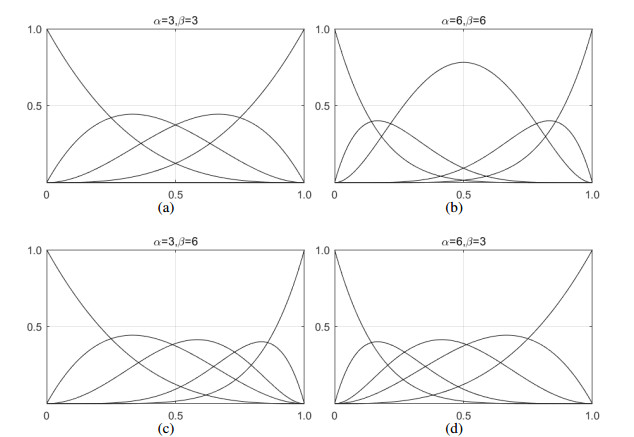









 DownLoad:
DownLoad:

